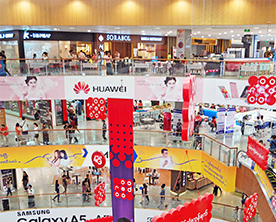Retail continues to be one of the best performing sectors in real estate with occupancy rates consistently registering in the high 90%. Rental rates also continue to trend upward notwithstanding the substantial rise in new supply according to Colliers International Myanmar’s latest quarterly Yangon Retail Report for 2017.
The retail sector closed the year strong with an occupancy rate of 95%. Demand has consistently been growing despite the limited number of retail brands in the market. Joan Mae Lee, Analyst for Colliers’ Research and Advisory team commented “Though shopping malls contain a similar tenant mix, the high occupancy rate indicates bullish business sentiment from retailers.” Lee further explained that the increasing space requirements are driven by the continuous shop expansions as well as purchases of foreign franchises.
According to the report, new supply grew by more than 79,400 sq m in 2017, more than double the stock introduced the year before. The past year has also seen notable improvements with new developments upgrading the shopping experience. “Recently opened shopping malls have started adopting more modern features with higher ceilings, wider common spaces, better natural lighting and unique installations. Tenant segmentation is also getting more defined with select shopping malls now having dedicated I.T. zones, food and beverage, and entertainment zones.” pointed out Joshua De Las Alas, Senior Analyst for Research and Advisory for Colliers.
Developments which remain outdated and poorly maintained were forced to close resulting in a total end of year stock of more than 326,800 sq. m of leasable space. Upcoming retail for 2018 is quite substantial with more than 121,400 sq. m of leasable space. The majority of these are integrated in mixed-use developments mostly located in the Inner City Zone. On the other hand new supply for 2019 and 2020 is quite meagre. “We advise developers to take advantage of this opportunity,” emphasised De Las Alas. He stated that lifestyle-oriented developments offering leisure and recreational facilities stand to draw families and the growing young population. “Moreover, future developments should likewise be reinforced with a well curated and wider array of tenants” added De Las Alas. Though tenants are still mostly focused on apparel and food & beverage, the creation of a more all-inclusive destination comes highly recommended. “Landlords should aim to lure other prospective tenants such as aesthetic clinics, wellness centres, showrooms, auxiliary service providers, and inclusion of institutional occupiers to further boost foot traffic” said Lee.










